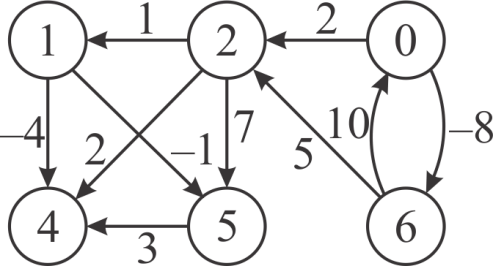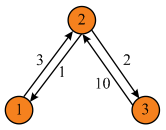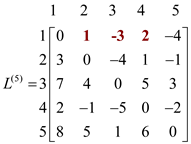Consider the following figure given in the text book.

Running SLOW-ALL-PAIRS-SHORTEST-PATH algorithm:
• The total number of rows in the weight matrix W of the given
graph,  .
.
• Prepare the initial matrix  by
assigning the W to
by
assigning the W to . Thus, the
initial matrix
. Thus, the
initial matrix  will be as
follows:
will be as
follows:

• For loop in the SLOW-ALL-PAIRS-SHORTEST-PATH calculates the
sequence of matrices ( ).
).
• EXTENDED-SHORTEST-PATH algorithm is used to find .
.
Now, run the SLOW-ALL-PAIRS-SHORTEST-PATH algorithm on the given graph. Then, the sequence of matrices that computed by the SLOW-ALL-PAIRS-SHORTEST-PATH algorithm in each iteration are as follows
Step1:

Step2:

Step 3:

Step 4:

Step 5:

The above matrix is the final matrix computed by the
SLOW-ALL-PAIRS-SHORTEST-PATHS ().  contains
the shortest-path weights.
contains
the shortest-path weights.
• The total number of rows in the weight matrix W of the given
graph,  .
.
• Prepare the initial matrix  by
assigning the W to
by
assigning the W to . Thus, the
initial matrix
. Thus, the
initial matrix  will be as
follows:
will be as
follows:

• Initialize the value of m by 1.
• While loop in the FASTER-ALL-PAIRS-SHORTEST-PATH algorithm
computes the sequence of matrices ( ).
).
• EXTENDED-SHORTEST-PATH algorithm is used calculate the
matrix .
.
Now, run the FASTER-ALL-PAIRS-SHORTEST-PATH algorithm on the given graph. Then, the sequence of matrices that computed by the FASTER-ALL-PAIRS-SHORTEST-PATH algorithm in each iteration are as follows:
Step 1:

Step 2:

Associability of matrix multiplication defined by EXTEND-SHORTEST-PATHS
A matrix multiplication is associative, that is, if A,
B and C are two matrices, then . Consider
C be the product of two
. Consider
C be the product of two  matrices
A and B. Then each element in C can be
represented as
matrices
A and B. Then each element in C can be
represented as

Algorithm for Matrix Multiplication:
Input Parameters: A, B
Output Parameter: C
MATRIX- MULTIPLICATION (A,B)
// assign the value of rows into a variable n
n=A.rows
Assume C be an  matrix
matrix
// iterate the loop for rows of first matrix from initial position to final position
for i=1 to n
// iterate the loop for rows of second matrix from initial position to final position
for j=1 to n
// initialize all the elements of the resultant matrix with 0
cij=0
// iterate the loop for storing the element after performing multiplication
for k=1 to n
// Multiply the element of matrix a and b and add it with the
// element of matrix c and after that assign the result in c matrix
cij=cij+aik bkj
bkj
return C
Algorithm to prove associativity of matrix multiplication which is defined by EXTEND-SHORTEST-PATHS:
Now consider be the
product of three matrices A, B and C
be the
product of three matrices A, B and C
n=A.rows
let D be an  matrix
matrix
// iterate the loop for rows of first matrix from initial position to final position
for i=1 to n
// iterate the loop for rows of second matrix from initial position to final position
for j=1 ton
// initialize all the elements of the resultant matrix with 0
dij=0
// iterate the loop for storing the element after performing multiplication
for k=1 to n
// Multiply the element of matrix a and b and add it with the
// element of matrixd and after that assign the result in d matrix
dij=dij+aik bkj
bkj
return D
m=D.rows
let E be an  matrix
matrix
// iterate the loop for rows of first matrix from initial position to final position
for i=1 to m
// iterate the loop for rows of second matrix from initial position to final position
for j=1 to m
// initialize all the elements of the resultant matrix with 0
eij=0
// iterate the loop for storing the element after performing multiplication
for k=1 to m
// Multiply the element of matrix a and b and add it with the
// element of matrixe and after that assign the result in e matrix
eij=eij+dik ckj
ckj
return E
Same way,  can be
represented as shown below:
can be
represented as shown below:
n=B.rows
let D be an  matrix
matrix
// iterate the loop for rows of first matrix from initial position to final position
for i=1 to n
// iterate the loop for rows of second matrix from initial position to final position
for j=1 to n
// initialize all the elements of the resultant matrix with 0
dij=0
// iterate the loop for storing the element after performing multiplication
for k=1 to n
// Multiply the element of matrix a and b and add it with the
// element of matrixd and after that assign the result in d matrix
dij=dij+bik ckj
ckj
return D
m=A.rows
let E be an  matrix
matrix
// iterate the loop for rows of first matrix from initial position to final position
for i=1 to m
// iterate the loop for rows of second matrix from initial position to final position
for j=1 to m
// initialize all the elements of the resultant matrix with 0
eij=0
// iterate the loop for storing the element after performing multiplication
for k=1 to m
// Multiply the element of matrix a and b and add it with the
// element of matrixe and after that assign the result in e matrix
eij=eij+aik dkj
dkj
return E
Illustration of associativity of matrix multiplication using mathematics:
By using mathematics, it can be proved as shown:
Now, consider be the
product of three matrices A, B and C.
be the
product of three matrices A, B and C.
Here, S can be represented as,

Where,  =
= 
Here,  is the
product of two matrices A and B.
is the
product of two matrices A and B.

By using mathematics, it can be proved as shown:
Same way  can be
represented as shown below:
can be
represented as shown below:

Where,  =
= 
Here,  is the
product of two matrices A and B.
is the
product of two matrices A and B.

Thus, 
Hence, matrix multiplication defined by EXTEND-SHORTEST-PATHS is associative.
Example to illustrate associativity of matrix multiplication defined by EXTEND-SHORTEST-PATHS:
Consider the graph of matrix A and calculate the shortest path of the graph as shown below:





The final matrix is . Now,
consider
. Now,
consider  as matrix
A. Colored entries in the matrix shows the shortest distance
by using intermediate vertex.
as matrix
A. Colored entries in the matrix shows the shortest distance
by using intermediate vertex.
Consider the graph of matrix B and calculate the shortest path of the graph as shown below:





 . Now,
consider
. Now,
consider  as matrix
B.
as matrix
B.Consider the graph of matrix C and calculate the shortest path of the graph as shown below:





The final matrix is . Now
consider
. Now
consider  as matrix
C.
as matrix
C.
Multiplication of three matrices: Multiplication of three matrices A, B and C are as follows:


Here, it can be seen that  and
and
 are
equal.
are
equal.
Hence, it is proved that matrix multiplication in associative.
The all-pairs shortest paths algorithm computes.


Where  and
and
 is
the identity matrix. It means the that the entry in the
ath row and bth column of the
matrix. Here, “PRODUCT” of the distance from vertex a to
vertex b to the row I is the solution of the of the
single source shortest path.
is
the identity matrix. It means the that the entry in the
ath row and bth column of the
matrix. Here, “PRODUCT” of the distance from vertex a to
vertex b to the row I is the solution of the of the
single source shortest path.
Now the multiplication of the matrix is calculated by the product of ath row of first matrix to the bth column of the second matrix and get the solution matrix row a.
In the solution matrix, to get the single-source shortest-paths
from vertex I is the difference between the first row to the
current position and for rest of the entries it will be  .
.
Bellman-Ford Algorithm is the algorithm that calculates the shortest path from initial node to the final node. In this algorithm, first row is same calculated as above calculated “MULTIPLICATIONS”.
The vector for the solution matrix is initially 0 same like
Bellman-Ford Algorithm and  for other
vertices. Here, the distance between the vertices is updated in the
solution matrix to a smaller estimate. It is formed by adding some
for other
vertices. Here, the distance between the vertices is updated in the
solution matrix to a smaller estimate. It is formed by adding some
 to
the current estimate of the distance to u.
to
the current estimate of the distance to u.
The multiplication is done  times.
times.
For every vertex  which are
the source, compute the trees for
which are
the source, compute the trees for  which are
of shortest paths.
which are
of shortest paths.
To implement the above, for each , compute
the predecessor.
, compute
the predecessor.
For the fixed value of i and j, the value of k is this such that the following:

Since, there are n number of vertices whose trees needs the computation.
The n number of vertices for each of the tree whose predecessor needs the computation, takes the following time for each of the one:

Thus, the total time taken is  .
.
SHORTEST PATH
The predecessor matrix of shortest path is a matrix  which can
be computed as follows,
which can
be computed as follows,
 is NILL if
is NILL if
 or
there is no path from
or
there is no path from 
AND
Otherwise  is the
predecessor of j on some shortest path from i.
is the
predecessor of j on some shortest path from i.
EXTENDED-SHORTEST-PATH algorithm accepts a weight Matrix
W and initial matrix  and
returns
and
returns .
.
Where,  be the
minimum weight of any path from vertex i to vertex j
and it contains at most m edges.
be the
minimum weight of any path from vertex i to vertex j
and it contains at most m edges.
Now,  can be
computed using EXTENDED-SHORTEST-PATH as follows:
can be
computed using EXTENDED-SHORTEST-PATH as follows:

So to compute predecessor, the extended shortest path algorithm is given below:
PREDECESSOR-EXTENDED-SHORTEST-PATH (L, W)
// Assign the value of rows for matrix l into the variable n
n = l.rows
Suppose L’ = (l’ij) be a new  matrix
matrix
Suppose  be a new
be a new
 matrix
matrix
// iterate for loop for the rows of the first matrix
for i = 1 to n
// iterate for loop for the rows of the second matrix
for j = 1 to n
// firstly assign all the element of the matrix with infinity

// Assign all the elements of the matrix with null

// iterate for loop for resultant matrix
for k = 1 to n
// Calculate shortest path by applying the following formula


return L’
Above algorithm is written without superscripts to make its input and output matrices independent of m.Value of  can be
computed by above algorithm for the graph which is as shown
below:
can be
computed by above algorithm for the graph which is as shown
below:



 Since
SLOW-ALL-PAIR-SHORTEST-PATH is internally using
EXTENDED-SHORTEST-PATH, the procedure which is discussed in
the above part can be extended to t.
Since
SLOW-ALL-PAIR-SHORTEST-PATH is internally using
EXTENDED-SHORTEST-PATH, the procedure which is discussed in
the above part can be extended to t.
In the above matrix, if there is any edge from vertex i to j, then path will also exist between them and assign value of weight in (i, j)th position in the matrix.
Here k = 0, which implies that there is no intermediate vertex from vertex i to j.

Calculate the predecessor matrix p after the calculation of L(k). Calculate the matrix p asp(1), p(2), …… p(n) till the matrix p(n) is not equal to the matrix p(n-1).
Formulate the pij(k)for k = 0, which means that there is no intermediate vertex between the vertex i to vertex j.

Now for k = 1, vertex “1” can be an intermediate node. Compute L(1)for finding the shortest path from all the vertices with intermediate vertices 1. Then, the corresponding L(1) matrix will be as shown:

Formulate pij(1)for k = 1, which means that there is one intermediate vertex which is “1” between the vertex i to vertex j.Compute p(1) for finding the shortest path from all the vertices with intermediate vertices 1. Then the corresponding matrix p(1) will be as shown:

Now for k = 2, so, vertex “2” can be an intermediate node. Compute L(2) for finding the shortest path from all the vertices with intermediate vertices 2. Then, the corresponding L(2) matrix will be as shown:

Formulate the pij(2)for k = 2, which means there is two intermediate vertex which is “2” between the vertex i to vertex j. Compute p(2) for finding the shortest path from all the vertices with intermediate vertices 2. Then the corresponding matrix p(2) will be as shown:

Now for k = 3, vertex “3” can be an intermediate node. Compute L(3)for finding the shortest path from all the vertices with intermediate vertices 3. Then the corresponding L(3)matrixwill be as shown:

Formulate the pij(3)for k = 3, which means there is one intermediate vertex which is “3” between the vertex i to vertex j. Compute p(3) for finding the shortest path from all the vertices with intermediate vertices 3. Then the corresponding matrix p(3)will be as shown:

Now for k=4, vertex “4” can be an intermediate node. Compute L(4)for finding the shortest path from all the vertices with intermediate vertices 4.
Then the corresponding L(4)matrix will be as shown:

Formulate the pij(4) for k = 4, which means there is one intermediate vertex which is “4” between the vertex i to vertex j. Compute p(4) for finding the shortest path from all the vertices with intermediate vertices 4. Then, the corresponding matrix p(4) will be as shown:

Now for k = 5, vertex “5” can be an intermediate node. Compute L(5)for finding the shortest path from all the vertices with intermediate vertices 5. Then the corresponding L(5) matrix will be as shown:

Formulate the pij(5 for k = 5, which means there is one intermediate vertex which is “5” between the vertex i to vertex j.
Compute p(5) for finding the shortest path from all the vertices with intermediate vertices 5. Then, the corresponding matrix p(5) will be as shown:


FASTER-ALL-PAIRS-SHORTEST-PATHS
The FASTER-ALL-PAIRS-SHORTEST-PATHS algorithm, in the each iteration of the while loop, calls EXTEND-SHORTEST-PATHS (L(m),L(m)) and stores the resultant matrix returned by the EXTEND-SHORTEST-PATHS procedure.
• In each iteration, to store the resultant matrix returned by
the EXTEND-SHORTEST-PATHS procedure, The
FASTER-ALL-PAIRS-SHORTEST-PATHS algorithm creates a space for the
new matrix (L(2m)) of size
 .
.
• Since the while loop runs  times, the
algorithm required to store space for
times, the
algorithm required to store space for  new
matrices.
new
matrices.
• Since each matrix contains  elements,
the total space required to store the
elements,
the total space required to store the  matrices
is
matrices
is .
.
But the algorithm can be modified, such that the algorithm takes
only space.
space.
Modifying the FASTER-ALL-PAIRS-SHORTEST-PATHS algorithm such
that the algorithm takes only  space:
space:
• Instead of creating a new matrix inside the while loop in each
iteration, create only one matrix (L
(2m)) of size  outside the
while loop.
outside the
while loop.
• Now override the previously calculated matrices by newly calculated matrices.
• Due to the above modification, the algorithm only requires to
create space for only two matrices, L (1) and
L (2m) of size .
.
• Hence, the space required is  and the
space complexity will be
and the
space complexity will be .
.
The modified FASTER-ALL-PAIRS-SHORTEST-PATHS procedure will be as follows:
FASTER-ALL-PAIRS-SHORTEST-PATHS
1 
2 
3 
4 let  be a
be a
 matrix
matrix
5 while 
6  EXTEND-SHORTEST-PATHS
EXTEND-SHORTEST-PATHS
7 
8 return 
Hence, the space complexity of above modified
FASTER-ALL-PAIRS-SHORTEST-PATHS algorithm is  .
.
Modification of FASTER-ALL-PAIRS-SHORTEST-PATHS
Shortest path:
Shortest path for a weighted directed graph is the shortest weight from going through source vertex to the destination vertex by traversing all the vertices of the graph. Shortest path does not contain cycle and it is not necessary for a shortest path to satisfy the property of triangle inequality. Cost of the shortest path is computed by summing the cost of the edges which are coming in the way from going from one vertex to another.
All pair shortest path:
All pair shortest path algorithm is used to find the shortest for a Graph G = (V, E). Suppose a path p is the shortest path from going through vertex i to vertex j and it is include minimum one edge and maximum m edges. Edges are finite, if and only if graph does not contain negative weight cycle.
If the source and destination vertex are same then path p contain no edges. If source and destination vertex are different then find the path p from vertex i to vertex j by going through intermediate vertices k. The path from source vertex to intermediate vertex is represented by p’.
Computation of shortest path from vertex i to vertex
j is easy if  .
.
Negative Weight cycles:
A negative cycle is a cycle in a weighted graph whose total weight is negative.
Consider the graph shown below.

 . Calculate
shortest path from a to d in above graph then it will
provides a shortest path
. Calculate
shortest path from a to d in above graph then it will
provides a shortest path , which is
not true. In extended shortest path, which is used in fast shortest
path algorithm, if the diagonal of L matrix are computed
then it contains negative value then definitively there will be a
negative cycle in the graph. So, in extended shortest by
checking
, which is
not true. In extended shortest path, which is used in fast shortest
path algorithm, if the diagonal of L matrix are computed
then it contains negative value then definitively there will be a
negative cycle in the graph. So, in extended shortest by
checking for all
for all
 whose
whose  , help in
determining whether the graph contain negative cycle or not.
, help in
determining whether the graph contain negative cycle or not.Faster all pair shortest path:
In Faster all pair shortest path, for a graph G =
(V, E) includes a cycle of negative weight but the
condition is that  and the
value m>n–1.
and the
value m>n–1.
The algorithm given below finds the negative cycles in the graph W. This uses the algorithm EXTEND-SHORTEST-PATHS to get the matrix that holds the shortest paths for the concerned graph.
EXTEND_SHORTEST_PATHS is defined in the section 25.1 of the book.
Modify Extend-Shortest-Paths Algorithm:
EXTEND-SHORTEST-PATHS (L, W)
//get the number of rows in the matrix representing graph

Assume  is a square
matrix
is a square
matrix
//go through the matrix elements
for i=1 to n
//go through the matrix elements
for j=1 to n
// Initialize all the matrix element with 

// Iterate for loop for the result in the matrix
for k=1 to n

return L’
If there is a negative weight cycle in a Graph G, then
create a lower value by going through the cycle continuously and
thus the condition is that
Modified-faster-all pair shortest-path algorithm
MODIFIED-FASTER-ALL PAIR SHORTST-PATH (W)
//get the number of rows in the matrix representing graph

//store the matrix locally for calculation


//run a loop through the matrix rows to get the paths
while 
//store the current path and consider the section 25.1 from the textbook
Let 
//go through the matrix elements
for i = 1 to n
for j = 1 to n
if 
retu rn negative cycle detected

return 
The determination of negative weight cycle in the matrix L(n-1)can be made by seeing at the diagonal, which is calculated from all-pairs shortest path algorithm. Negative weight cycle is present in the graph, if the diagonal of the matrix contains negative weight numbers.
If negative weight cycle is present in the graph, then there exists a path (weight negative) of length k = n for diagonal vertex.
Thus, in the matrix multiplication, negative value is found at the diagonal matrix Wm is produced for all m = k. Due to this reason modification in the algorithm is made by replacing Wn-1with Wn.
An efficient algorithm to find the length (number of edges) of a minimum length negative-weight cycle in a graph is as follows:
FIND-MIN-LENGTH-NEG-WEIGHT-CYCLE (W)
1. n = w.rows
2. L(1) = W
3. m = 1
4. while m n and no
diagonal entries of L(m) are negative
n and no
diagonal entries of L(m) are negative
5. L(2m) = EXTEND-SHORTEST-PATHS(L(m), L(m))
6. m = 2m
7. if m > n no diagonal entries of L(m) are negative
8. then return “no negative-weight cycles”
9. elseif m  2
2
10. then return m
11. else
12. low = m/2
13. high = m
14. d = m/4
15. while d 1
1
16. s= low + d
17. L(s)=EXTEND-SHORTEST-PATHS(L(low),L(d))
18. if L(s) has any negative entries on the
diagonal then
19. high = s
20. else
21. low=s
22. d = d/2
23. return high
For some values of m and i, , the cycles
of the negative weight occur.
, the cycles
of the negative weight occur.
Every time the new value of W is computed and at each time it is being checked that whether this is happened or not.
And at which point the length of the cycle be m.
The runtime would be .
.

